The Venue
The Venue (& things to do whilst there)
 About Castello di Meleto
About Castello di Meleto
Driving through the stunning landscape of the Chianti region of rolling hills, sun-kissed fields, cypress allees and vineyards as far as the eye can see, you can’t help but be impressed when you first see Castello di Meleto with his powerful structure rising on a gentle hill.
The castle is located a small distance from the border of the ancient Republic of Siena and Florence about 1km from Gaiole in Chianti(Siena), a small village which has always played an important role as market centre for the castles and towns nearby.
Built in 1269 by Benedictine monks, the castle is steeped in history. We fell in love with the peacefulness and beauty of the castle, its frescoed rooms, its gardens and breath-taking views, and knew instantly that we have found the venue for our wedding.
The property stretches 2,471,000 acres, 180 of which are used to cultivate the grapevines.
The castle is famous for its wine production. It produces 4 major wines: Chianti Classico DOCG, Chianti Classico DOCG Riserve, Fiore, and Rainero.
You will get the chance to taste their award winning wine and visit the cellars, which house 250.000 bottles of Chianti Classico DOCG, 50.000 bottles of Chianti Classico DOCG Reserve, and 50.000 bottles of Fiore. You won’t be thirsty…
For more information on the history of the castle please visit Castello di Meleto web site.
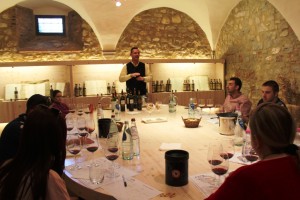 Vineyards & Wine Tasting
Vineyards & Wine Tasting
The wine shop is open for wine tastings from 10:00 a.m. until 6:00 p.m. during the summer months. We are booking some wine tasting sessions on the Friday and the Sunday. Please check Itinerary for details nearer the time.
Guided Tours
There are guided tours of the Castle, lasting approximately 30 minutes, during which you can admire the lovely frescoed rooms of the Piano Nobile (main floor), the small eighteenth-century theatre and the old subterranean wine cellar. Or you are free to just wonder around the Caste and the grounds during the days of the wedding as we have the whole venue booked out.
 Relaaaaaaxx (by the pool)
Relaaaaaaxx (by the pool)
There are two stunning infinity pools for us to relax and unwind at before and after the big day. We will be having a pool party on the day after the wedding (see Itinerary). There are also extensive grounds where you can take a stroll around the Tuscan countryside and many vineyards.
Restaurant
On the road that leads to the Castle, you will find the restaurant “La Fornace di Meleto“. This restaurant offers delicious and tasty traditional Tuscan dishes such as pici, Fiorentina and sweet tiramisu. The environment is charming and welcoming and the restaurant has ample parking and a spacious veranda. It is open daily for lunch and dinner.
Tuscany
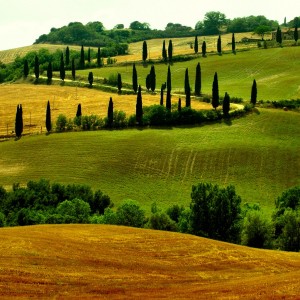 Surrounding Area
Surrounding Area
Chianti is without a doubt one of the most renowned wine-producing areas. And that’s not all. When thinking of the territory you cannot help but recall the cypress trees, the churches, and castles which dot the region. During Medieval times Gaiole in Chianti was an important merchant town set along the road to Valdarno. The many castles and parishes in the surrounding area are a testament to the flourishing and prosperous farms and businesses. Castellina in Chianti was turned into a fortress; the imposing stronghold set in the main town square is all that remains of it today. From its crenelated fourteenth-century tower you can admire the lovely Chianti landscape. Castelnuovo Berardegna is often viewed as an offshoot of Siena, since tourists do not consider it part of the province of Siena. The city and the surrounding countryside are charming areas, full of character and history, rich in architecture, gardens and historical locations. Radda in Chianti is set in the rolling hills surrounding the rivers Pesa and Arbia. Mentioned for the first time in a 11th century document, the town, the court and its castle were property of the Florentine Abbey. All that remains of the castle today are some sections of towers and segments of the wall; the framework of the old medieval town has been preserved. It surrounds the old church of Saint Nicholas and the fifteenth-century Palazzo del Podesta, currently the headquarters of City Hall. Radda is an important wine producing town, as well as the hub for trade in Chianti, the junction for the network of roads which link all the small towns and isolated farms San Gimignano rises with the outline of its towers on a hill (334 meters) overlooking Val d’Elsa. The site of a small Etruscan village during the Hellenistic era (III-II century b.C.) its story begins around the tenth century, when it was named after the Bishop of Modena: San Gimignano, who saved the town from barbarian hordes. It flourished during Medieval times thanks to the Via Francigena which crossed the town. The existing 15 medieval towers (a distant memory of the 72 towers the city had at the height of its glory) proclaim from afar the splendour of the Tuscan city.
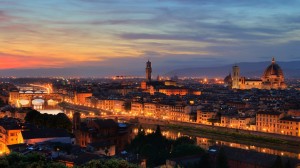 Florence
Florence
Florence’s museums, palaces, and churches house some of the greatest artistic treasures in the world. The most popular and important sites in Florence include the Cathedral, the Baptistery, the Uffizi, the Bargello, and the Accademia. The churches of Santa Maria Novella and Santa Croce are veritable art galleries, and the library of San Lorenzo is a magnificent exhibition of Michelangelo’s architectural genius. Wander some of the oldest streets in the city until you reach the Arno River, cross the Ponte Vecchio, and experience the “newest” area of Florence, the Oltrarno. Be sure to set aside time to see the vast and varied art collection housed in the Pitti Palace. When you grow weary of museums and monuments, head outdoors. Spend a day at the Boboli Gardens or climb the hill to the church of San Miniato al Monte to experience an enchanting view of Florence.
Lucca
Lucca, a living testimony to past times, kingdoms and dominions, lies in a green valley just north west of Florence This almost perfectly preserved jewel of medieval architecture and buildings, emanates charm and shows layers of history from every corner of its narrow winding streets.
Beginning in Roman times, continuing through the Middle Ages, on to the Napoleonic era and finally to the Risorgimento, Lucca’s monuments, churches, palaces and roads, even its very shape have a story to tell. Each layer blending with preceding ages marking the growth and changes of the city.
The broad, high walls, which characterize the city, are a feature of its past, and a pleasant element of its present.
Completely surrounding the ancient city, the walls we see today date back to the 17th century. Now, no longer used for defence, they are crowned by 4 km of green parkland, and are a lovely place to walk, cycle or stop for a picnic. Just another example of how, over the centuries, though buildings last, their roles metamorphose as times change.
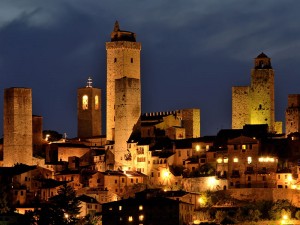 San Gimignano
San Gimignano
San Gimignano is a small walled medieval hill town in the province of Siena, Tuscany, north-central Italy. Known as the Town of Fine Towers, San Gimignano is famous for its medieval architecture, unique in the preservation of about a dozen of its tower houses, which, with its hilltop setting and encircling walls form “an unforgettable skyline”. Within the walls, the well-preserved buildings include notable examples of both Romanesque and Gothic architecture, with outstanding examples of secular buildings as well as churches. The Palazzo Comunale, the Collegiate Church and Church of Sant’ Agostino contain frescos, including cycles dating from the 14th and 15th centuries. The “Historic Centre of San Gimignano”, is a UNESCO World Heritage Site. The town also is known for the white wine, Vernaccia di San Gimignano, produced from the ancient variety of Vernaccia grape which is grown on the sandstone hillsides of the area.
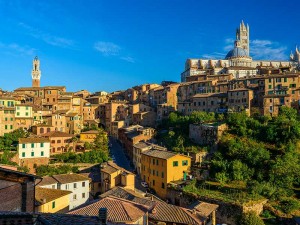 Siena
Siena
Siena is likely Italy’s loveliest medieval city, and a trip worth making even if you are in Tuscany for just a few days. Siena’s heart is its central piazza known as Il Campo, known worldwide for the famous Palio run here, a horse race run around the piazza two times every summer. Movie audiences worldwide can see Siena and the Palio in the James Bond movie,Quantum of Solace.
Siena is said to have been founded by Senius, son of Remus, one of the two legendary founders of Rome thus Siena’s emblem is the she-wolf who suckled Remus and Romulus – you’ll find many statues throughout the city. The city sits over three hills with its heart the huge piazza del Campo, where the Roman forum used to be. Rebuilt during the rule of the Council of Nine, a quasi-democratic group from 1287 to 1355, the nine sections of the fan-like brick pavement of the piazza represent the council and symbolizes the Madonna’s cloak which shelters Siena.
The Campo is dominated by the red Palazzo Pubblico and its tower, Torre del Mangia. Along with the Duomo of Siena, the Palazzo Pubblico was also built during the same period of rule by the Council of Nine. The civic palace, built between 1297 and 1310, still houses the city’s municipal offices much like Palazzo Vecchio in Florence. Its internal courtyard has entrances to the Torre del Mangia and to the Civic Museum. If you feel energetic, a climb up the over 500 steps will reward you with a wonderful view of Siena and its surroundings. The Museum, on the other hand, offers some of the greatest of Sienese paintings. The Sala del Concistoro houses one of Domenico Beccafumi’s best works, ceiling frescoes of allegories on the virtues of Siena’s medieval government. But it is the Sala del Mappamondo and the Sale della Pace that hold the palaces’s highlights: Simone Martini’s huge Maestà and Equestrian Portrait of Guidoriccio da Fogliano and Ambrogio Lorenzetti’s Allegories of Good and Bad Government, once considered the most important cycle of secular paintings of the Middle Ages.
For more information about things to do and see in Tuscany visit http://www.discovertuscany.com/